Wenn Sie mit WordPress arbeiten, wissen Sie wahrscheinlich, wie wichtig es ist, Dinge zu testen, bevor Sie Änderungen an Ihrer Live Website vornehmen. Bei WPBeginner erstellen wir oft Test-Websites auf unseren Computern, um neue Themes und Plugins auszuprobieren. So können wir neue Dinge ausprobieren, ohne unsere Websites zu zerstören.
Eine der besten Möglichkeiten, eine Test-Website zu erstellen, ist die Verwendung eines kostenlosen Tools namens XAMPP. Mit XAMPP können Sie WordPress ganz einfach auf Ihrem eigenen Computer einrichten. Sie benötigen weder einen Webhost noch eine Internetverbindung, um eine Website auf Ihrem Computer zu erstellen.
In diesem Artikel zeigen wir Ihnen, wie Sie ganz einfach eine lokale WordPress-Website mit XAMPP erstellen können. So haben Sie einen sicheren Ort, um mit WordPress zu experimentieren, neue Dinge auszuprobieren und Ihre Fähigkeiten bei der Website-Entwicklung zu verbessern, ohne Ihre Live-Websites zu beeinträchtigen.

Warum eine lokale WordPress-Website erstellen?
Die Erstellung lokaler WordPress-Websites ist eine gängige Praxis unter Entwicklern und Website-Besitzern. Damit können Sie WordPress testen, ohne eine echte Website im Internet zu erstellen.
Lokale Websites sind für Sie nur auf Ihrem Computer sichtbar. Sie können verschiedene WordPress-Themes und Plugins ausprobieren, ihre Funktionen testen und die WordPress-Grundlagen erlernen.
Wenn Sie bereits eine WordPress-Website haben, können Sie eine lokale Kopie Ihrer Website auf Ihrem Computer erstellen, um neue Plugin-Updates auszuprobieren, bevor Sie sie auf Ihrer Live-Website implementieren.
Wichtig: Eine lokale Website ist für Sie nur auf Ihrem Computer sichtbar. Wenn Sie eine Live-Website erstellen möchten, benötigen Sie einen Domainnamen und WordPress-Hosting.
Folgen Sie den Schritt-für-Schritt-Anweisungen in unserem Leitfaden zum Starten eines WordPress-Blogs, wenn Sie bereit sind, eine Live-Website zu erstellen.
Schauen wir uns nun an, wie man WordPress lokal auf Windows, Mac oder Linux mit XAMPP installiert.
Was ist XAMPP?
XAMPP ist ein Softwarepaket, das alles enthält, was Sie brauchen, um eine lokale Serverumgebung auf Ihrem Computer einzurichten.
Um eine lokale WordPress-Site zu erstellen, müssen Sie eine Webserver-Software (Apache), PHP und MySQL auf Ihrem Computer einrichten.
PHP ist eine Programmiersprache, und MySQL ist eine Datenbankverwaltungssoftware. Beide sind erforderlich, um WordPress zu betreiben.
Sie separat zu installieren, ist für Anfänger ziemlich schwierig. An dieser Stelle kommt XAMPP ins Spiel.
XAMPP macht es Ihnen leicht, WordPress-Websites lokal zu erstellen. Es ist für Windows-, Mac- und Linux-basierte Computer verfügbar.
Beginnen wir mit der Installation von XAMPP und der Einrichtung der lokalen WordPress-Site.
XAMPP auf Ihrem Computer installieren
Zuerst müssen Sie die XAMPP-Website besuchen und auf die Schaltfläche “Download” für Ihr Betriebssystem klicken.
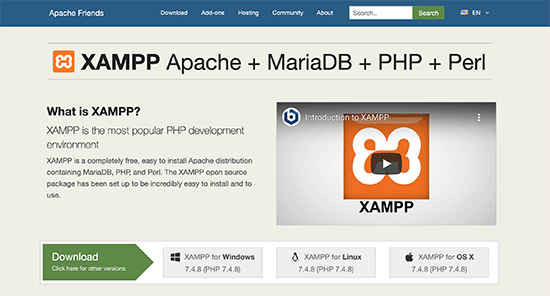
Je nach Betriebssystem können der Installationsassistent und die Benutzeroberfläche der Anwendung von den hier gezeigten Screenshots abweichen. Für diesen Artikel zeigen wir Ihnen die Windows-Version der Software.
Nachdem Sie XAMPP heruntergeladen haben, müssen Sie auf das Installationsprogramm klicken und es ausführen.
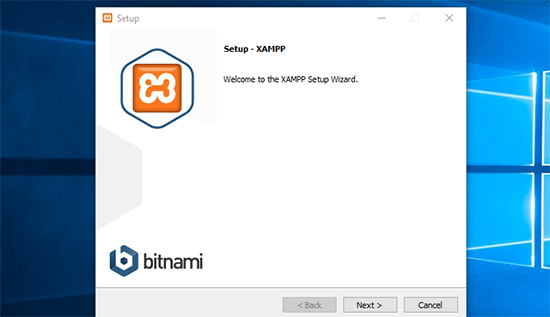
XAMPP wird Sie fragen, wo die Software installiert werden soll und welche Pakete Sie installieren möchten. Die Standardeinstellungen werden für die meisten Benutzer ausreichen. Klicken Sie weiter auf die Schaltfläche “Weiter”, um den Einrichtungsassistenten zu beenden.
Aktivieren Sie nach Abschluss des Assistenten die Option “Systemsteuerung jetzt starten” und klicken Sie dann auf die Schaltfläche “Fertig stellen”.
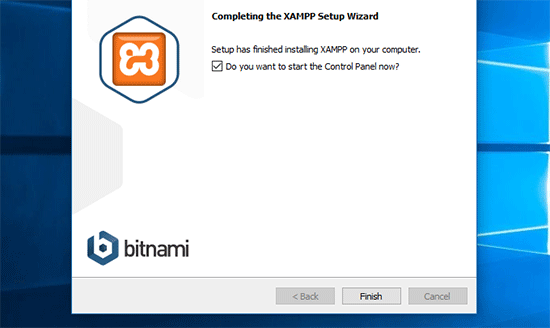
Dadurch wird die XAMPP-Kontrollfeld-App gestartet.
Mit der XAMPP-App können Sie den Apache-Webserver als lokalen Server und MySQL als Datenbankserver verwenden. Klicken Sie auf die Schaltfläche “Start” neben Apache und MySQL.
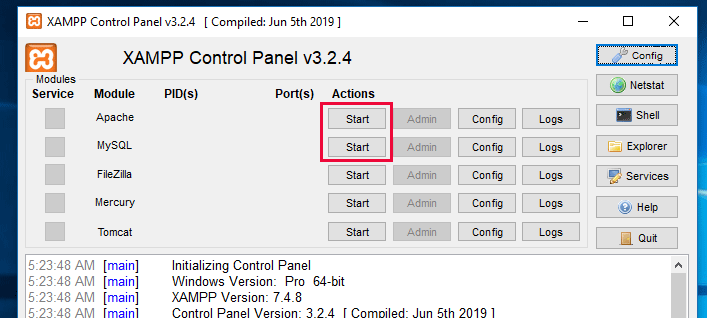
XAMPP wird nun Apache und MySQL starten.
Möglicherweise sehen Sie eine Benachrichtigung der Windows-Firewall. Es ist wichtig, dass Sie auf die Schaltfläche “Zugriff zulassen” klicken, damit beide Anwendungen auf Ihrem Computer ausgeführt werden können.
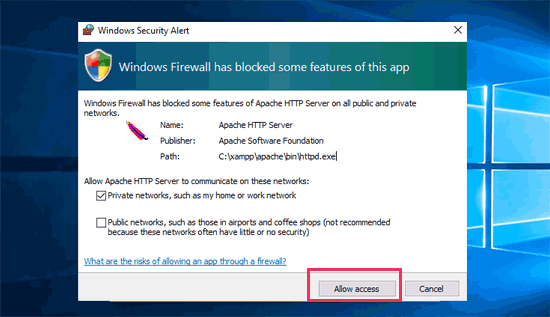
Sobald beide Anwendungen gestartet sind, werden ihre Namen grün hervorgehoben.
Nun sind Sie bereit, eine lokale Website zu erstellen und WordPress mit XAMPP zu installieren.
Erstellen einer lokalen WordPress-Site mit XAMPP
Zunächst müssen Sie WordPress herunterladen. Besuchen Sie die Website WordPress.org und klicken Sie auf die Schaltfläche “WordPress herunterladen”.
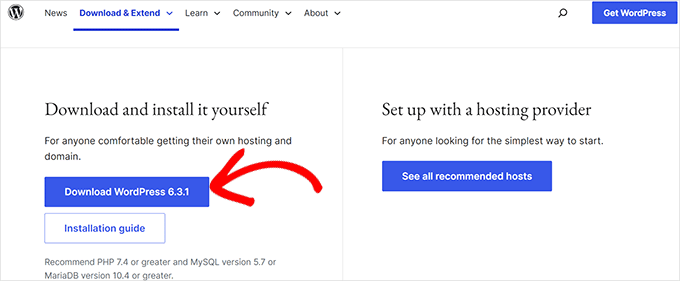
Nachdem Sie WordPress heruntergeladen haben, müssen Sie die Zip-Datei entpacken, und Sie werden einen WordPress-Ordner sehen.
Sie müssen diesen Ordner kopieren.
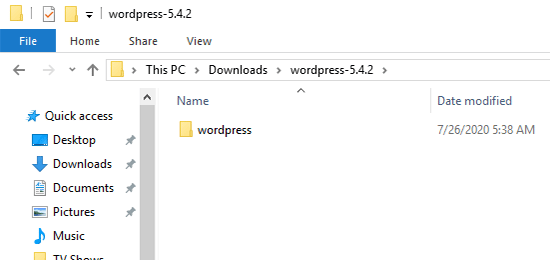
Als Nächstes gehen Sie zu Ihrem XAMPP-Installationsordner.
Unter Windows ist dies C:/Programme/XAMPP/htdocs oder C:/Xampp/htdocs.
Auf dem Mac ist dies /Applications/XAMPP/htdocs.
Fügen Sie den WordPress-Ordner, den Sie zuvor kopiert haben, in den Ordner “htdocs” ein.
Wir empfehlen, den Ordner “wordpress” in “website” oder etwas anderes umzubenennen. So können Sie Ihre lokale Website leichter identifizieren.
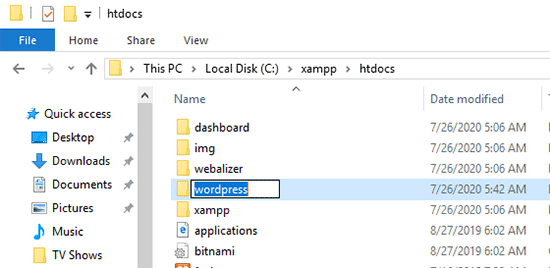
Als nächstes müssen Sie Ihren bevorzugten Webbrowser öffnen.
Sie können die folgende URL in die Adresszeile Ihres Browsers eingeben:
https://localhost/website1/
Wenn Sie den WordPress-Ordner umbenannt haben, stellen Sie sicher, dass Sie “website1” durch Ihren eigenen Ordnernamen ersetzen.
Daraufhin wird der WordPress-Installationsassistent geladen, und Sie werden aufgefordert, eine Sprache auszuwählen. Nachdem Sie eine Sprache ausgewählt haben, klicken Sie auf die Schaltfläche “Weiter”.
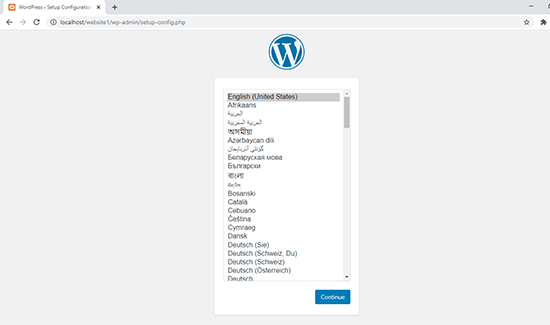
Auf dem nächsten Bildschirm sehen Sie den WordPress-Begrüßungsbildschirm.
Es enthält einen Hinweis, dass WordPress einen Datenbanknamen, einen Datenbankbenutzernamen, ein Passwort und Hostinformationen benötigt.
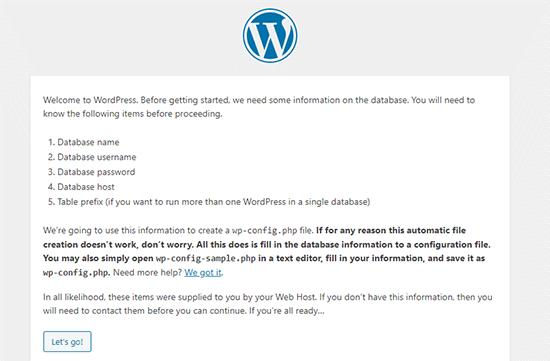
Lassen Sie uns eine Datenbank für Ihre WordPress-Website erstellen.
Sie müssen eine neue Browser-Registerkarte öffnen und https://localhost/phpmyadmin/ besuchen .
Dadurch wird die phpMyAdmin-Anwendung gestartet, die mit XAMPP vorinstalliert ist. Mit ihr können Sie Ihre Datenbanken über eine einfachere Schnittstelle verwalten.
Klicken Sie auf “Datenbanken” und geben Sie einen Namen für Ihre neue Datenbank ein. Danach klicken Sie auf die Schaltfläche “Erstellen”, um fortzufahren.
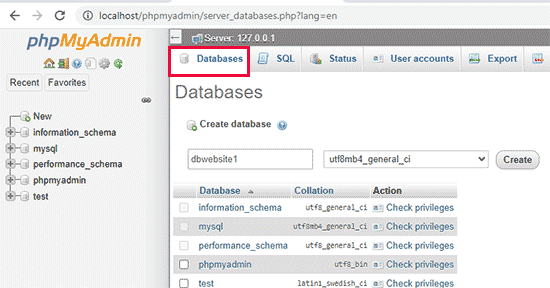
Nachdem Sie nun eine Datenbank erstellt haben, können Sie diese für Ihre WordPress-Site verwenden.
Wechseln Sie zurück zur Browser-Registerkarte /localhost/website1/ und klicken Sie auf die Schaltfläche “Los geht’s”.
Auf dem nächsten Bildschirm werden Sie aufgefordert, Ihre WordPress-Datenbankinformationen anzugeben.
Geben Sie den Namen der Datenbank ein, die Sie zuvor erstellt haben. Ihr Benutzername ist “root”, und das Passwortfeld sollten Sie leer lassen. Für das Feld Datenbank-Host müssen Sie localhost verwenden.
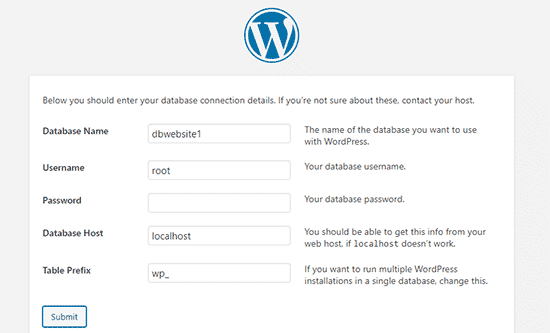
Wenn Sie fertig sind, klicken Sie auf die Schaltfläche “Absenden”, um fortzufahren.
Wenn Sie unter Windows oder Linux arbeiten, speichert WordPress diese Einstellungen nun in Ihrer WordPress-Konfigurationsdatei wp-config.php.
Wenn Sie jedoch mit einem Mac arbeiten, wird Ihnen der Inhalt der Datei angezeigt und Sie werden aufgefordert, sie zu erstellen.
Sie müssen diese Datei im Stammverzeichnis Ihrer Website erstellen.
Nachdem Sie die Datei erstellt haben, fügen Sie den zuvor kopierten Text in die Datei ein. Anschließend müssen Sie die Datei speichern und zum WordPress-Installationsprogramm zurückkehren, um fortzufahren.
Im nächsten Schritt werden Sie von WordPress aufgefordert, Informationen über Ihre Website anzugeben. Geben Sie zunächst den Titel ein, den Sie für diese Website verwenden möchten.
Danach müssen Sie einen Benutzernamen, ein Passwort und eine E-Mail-Adresse für Ihr Administratorkonto eingeben.
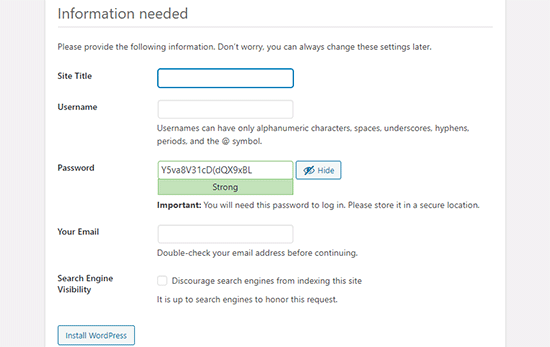
Sobald Sie alle Informationen eingegeben haben, klicken Sie auf die Schaltfläche “WordPress installieren”, um fortzufahren.
WordPress führt nun die Installation aus und fordert Sie auf, sich einzuloggen, sobald sie abgeschlossen ist.
Sie können sich bei Ihrer Website anmelden, indem Sie die Seite /localhost/website1/wp-admin aufrufen und den Benutzernamen und das Passwort verwenden, die Sie bei der Installation eingegeben haben.
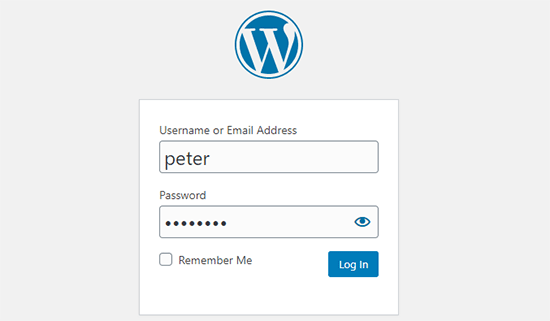
Was Sie nach der Erstellung einer lokalen WordPress-Website ausprobieren sollten
Jetzt, wo Sie Ihre lokale WordPress-Site mit XAMPP erstellt haben, können Sie sie wie eine Live-WordPress-Site bearbeiten.
Gehen Sie zum Menü “Erscheinungsbild” in der Seitenleiste der WordPress-Verwaltung, um das Erscheinungsbild Ihrer Website anzupassen oder ein neues Thema zu installieren.
Hier sind einige großartige kostenlose Themen, die Sie ausprobieren können.
Als nächstes sollten Sie versuchen, einige WordPress-Plugins zu installieren.
Plugins sind wie Apps für Ihre WordPress-Website und ermöglichen es Ihnen, coole Funktionen wie ein Kontaktformular, Schaltflächen für soziale Medien, einen eCommerce-Shop und vieles mehr hinzuzufügen.
Brauchen Sie Hilfe bei der Installation von Plugins? In unserer Schritt-für-Schritt-Anleitung erfahren Sie, wie Sie ein WordPress-Plugin installieren.
Bonus: Verschieben einer lokalen WordPress-Site auf einen Live-Server
Nachdem Sie an Ihrer lokalen WordPress-Website gearbeitet haben, möchten Sie sie vielleicht auf einen Live-Server verschieben, um Ihren ersten WordPress-Blog oder Ihre erste Website zu erstellen.
Dazu benötigen Sie einen Domänennamen und ein Webhosting-Konto. Normalerweise kostet ein Domänenname 14,99 $, und das Hosting einer Website beginnt bei 7,99 $ pro Monat.
Das ist zu viel, wenn Sie gerade erst anfangen.
Glücklicherweise bietet Bluehost den WPBeginner-Benutzern einen kostenlosen Domainnamen und einen großzügigen Rabatt auf das Hosting. Im Grunde können Sie für 1,99 $ pro Monat loslegen.
Weitere Hosting-Empfehlungen finden Sie in unserem vollständigen WordPress-Hosting-Leitfaden.
Sobald Sie sich für das Hosting angemeldet haben, können Sie unserer Schritt-für-Schritt-Anleitung folgen, wie Sie WordPress von einem lokalen Server auf eine Live-Site umziehen.
Vielleicht möchten Sie sich auch über die alternativen Möglichkeiten informieren, lokale WordPress-Sites unter Windows mit Wampserver und unter Mac mit MAMP zu erstellen.
Expertenleitfäden für lokale WordPress-Seiten
Wir hoffen, dass dieser Artikel Ihnen geholfen hat zu lernen, wie man eine lokale WordPress Website mit XAMPP erstellt. Vielleicht möchten Sie auch einige andere Anleitungen zu lokalen WordPress-Installationen lesen:
- Glossar: Localhost
- WordPress lokal auf dem Mac installieren (2 einfache Wege)
- So installieren Sie WordPress auf einem Windows-Computer (2 Methoden)
- WordPress von einem lokalen Server auf eine Live-Site verschieben (2 Methoden)
- Wie man eine Live-WordPress-Site auf einen lokalen Server verschiebt
- Wie man WordPress-E-Mails von Localhost mit SMTP empfängt
- WordPress Admin-Passwort auf Localhost zurücksetzen
- So erstellen Sie ganz einfach eine Staging-Site für WordPress (Schritt für Schritt)
Wenn Ihnen dieser Artikel gefallen hat, dann abonnieren Sie bitte unseren YouTube-Kanal für WordPress-Videotutorials. Sie können uns auch auf Twitter und Facebook finden.





André Bruwer
Hi there WPBEGINNER SUPPORT
Great article thank you
I was wondering… is it better to develop a wp website for a client live or better to build it locally then transfer it to the hosted wp site with duplicator or something similar?
Any advise would be greatly appreciated. Can’t figure this one out.
Thanks
André
WPBeginner Support
Hi André Bruwer,
It depends on developers own preferences. If a site hasn’t been live before then they can work on it using a maintenance mode or coming soon plugin. However, more developers prefer to work locally and then transfer a website to a live server.
Admin
demola
pls i want to move my wordpresite from my laptop to another laptop i use xamp as a local server
Thomas James Keely
I was up and running within minutes. Thank you so much!!!
Chaitra
Hi, I am getting following error when I connect to localhost/website1
You don’t have permission to access /website1/ on this server.
Additionally, a 403 Forbidden error was encountered while trying to use an ErrorDocument to handle the request.
Chaitra
Hi, I get the following error when I access localhost/website1 –
You don’t have permission to access /website1/ on this server.
Additionally, a 403 Forbidden error was encountered while trying to use an ErrorDocument to handle the request.
Jay
your article is very helpful for wp beginner.
rocky
Thanks for the Knowledge but how can i make it live through Xampp. Let us know if theres any tutorial
bala
yes there is a way to put your localhost online, you should redirect your domain name to your computer’s ip address
Jojo
Hi,
I followed your tutorial and created a wordpress site. How can I create another local wordpress site with this setup?
sekar ramu
Thanks. Simple and Straightforward
Eleazar
Hi Guy. Your tutorial is very straightforward. I liked it. Very clear and easy to follow. Tkanks
Jerry
Very straight forward tutorial! Thank you.
krishan pal singh
Very helpful tutorial for me… Thank you so much
paul
hi, i have been able to login to wordpress using xampp, but when i click on the themes area i only see three themes. when i try to install a new theme, im notified that there is an error. please i need your help.
Shamrat Hossain
This article was really helpful for me . Hope You will be doing good works like this for us in future ..
Thanks
Abhijith
Hi Team
I have problem with xampp server once installation itz working fine after shutdown if am going to using again in the xamm server buttons not working
it asking again and again tomcat file….please let me know how to fix it
Suraj Barthwal
you’r article was really helpful. i do have a query for you though, what should i do if i wanted to extract my wordpress live website so i could use it in future.
Mario Bergeron
Hi,
Thanks for your article really helpful. Everything works fine, installation etc., but I try to install a theme on my WP and i got this message ”The uploaded file exceeds the upload_max_filesize in php.ini.” What can I do to install my theme??
Thank you to help me.
Mario Bergeron
WPBeginner Support
Hi Mario,
Please see our guide on how to increase maximum file size upload limit in WordPress.
Admin
JERSon
Hi ALL,
im stuck at localhost/website1 …it will give the error page
This site can’t be reached
localhost refused to connect.
Search Google for localhost website1
ERR_CONNECTION_REFUSED
Please help
Innocent
Make sure your apache and mysql is running. Then try again
Emmanuel
Hello WordPress, I have installed and used Xampp yesterday and it worked very fine but whike trying to open and use it today, its taking back to the installation process and asking for a new storage location. How do I go about this?
ayush singh chauhan
Sir , when i try opening localhost/website1
then something else opens which is not similar to yours.
that is showing index of website ..
what should i do now
WPBeginner Support
Hi Ayush,
Restart XAMPP and then try again.
Admin
Stanley
When I finish with a website and wish to build another different website, how do I go about it? Thanks.
WPBeginner Support
Hi Stanley,
Create a new folder for your website inside htdocs folder and repeat all the steps mentioned under ‘Creating a Local WordPress Site with XAMPP’ section.
Admin
Jonathan Pienaar
Great tutorial, and works 99% for Linux. (I had to create wp-config.php manually for some reason).
Only other issue: trying to use the Elementor Page Builder plugin, but it requires an FTP login/password. Tried starting FTP server, but can’ figure out how to configure it so that I can give Elementor FTP access/download the plugin.
(Hope this makes sense).
Bhagwat Pawar
nice and practically perfect. can i add email functionality here installing gmail smtp or wp smtp plugin
Jane
This was so easy to follow. Thank you very much,
When I want to upload a theme in my new wordpress I get this error: ‘The uploaded file exceeds the upload_max_filesize directive in php.ini.’
Can I do anything about this?
WPBeginner Support
Hi Jane,
Please see our guide on how to increase maximum file upload size in WordPress.
Admin
Kumar
Thank you! Wonderfully detailed step-by-step instructions. Was able to install WordPress on my local machine without a problem. Much appreciated.
Julie
I am having the same problem James had:
Hi! I have successfully installed my xamp server, wordpress and database. My question is, after logging in to wordpress, I cannot see any dashboard panel wherein I can edit my themes and install plugins. Please help! Thanks.
Has anyone found a solution?
Thanks!
Eleonro
Hi, I have issues at login, when I try to log on, wp server says its invalid, what can I do?
James
Hi! I have successfully installed my xamp server, wordpress and database. My question is, after logging in to wordpress, I cannot see any dashboard panel wherein I can edit my themes and install plugins. Please help! Thanks.
Ruma
when I am submitting my data base name,username and password it is saying try again i have written each and every thing right name
Kenny
Leave the password space blank
Dani
To anyone having an issue with the localhost/website1 link not working, how I got it to work (on mac, might work for windows) was heading over to the Network tab in XAMPP and pressing enable. Then I took the port number (in my case it was localhost:8080) and then added that to the url. It looked like localhost:8080/website1.
Good luck!
Maria
Dani, Thanks so much for your post. I was having the same issue. After reading your post, I was able to get to the next step. few!
Hillary
I have set up the WordPress website, but yet i am still having issues upload some plugins that come with the themes i want to use. How do i get to correct this?
Thanks
Maheshwaran
Thanks you so much.. Your step by step contents helps me lot.
Nicholas
Thanks you so much ..
But i have faced one problem, after putting WordPress files into htdocs, i went to my browser and searched for “localhost/WordPress ” and i got ” error 404 Object not found ” how can i please fix that problem?
Thanks
Amokola Stephen
Did you start services in your local server(xamp)? if not please navigate xamp control panel and make sure that you start apache and mysql services
Alexander
I really like your post, thank you for sharing such a great post. Setting up wordpress website on localhost using XAMPP is the best solution you have. It gives you an option to explore themes and plugins as well. When i was researching how to work on localhost i have found two great resources through which anyone can easily learn to launch wordpress using localhost.
https://www.wpbeginner.com/wp-tutorials/how-to-create-a-local-wordpress-site-using-xampp/
Aligo
Thank you very much for this article.. I really followed it and was successful in creating the website
DavidA
Thank you for this article — it is great to be able to work at the website locally before exposing it to the world.
Is it possible to have more than one website locally? I have another site that I need to modify/see locally. How would I add this to the other without getting them mixed?
Thank you
WPBeginner Support
Hi,
You can add more websites by simply adding a new folder under /XAMPP/htdocs/.
Admin
DavidA
Thank you – the WPBeginners site/articles/support team have been a God-send.
Please keep doing what you are doing!(:0)!
Stanley
Thanks at WP team. I added another WordPress folder and it’s not working. I named this second folder WordPress1 since the first site database is WordPress and it didn’t work. Please, do help. Thanks.
WPBeginner Support
Hi Stanley,
Do you see an error when you visit the website in your browser?
Trifina
For Mac users you recommended:
“You will need to create this file in your website’s root folder.”
Can you elaborate? Where can i find this folder?
WPBeginner Support
Hey Triffina,
Normally, your XAMPP website folders are stored in /Applications/XAMPP/xamppfiles/htdocs/ folder.
Admin
Ann
followed all the steps but when i put “localhost/website1”, it shows an error saying “Error establishing a database connection”, also tried restarting my xampp, yet still the same problem exist.
Mike
Get an Object not found message when I put the localhost/website1 in my browser. It reads the following:
Error 404
localhost
Apache/2.4.25 (Win32) OpenSSL/1.0.2j PHP/5.6.30
Any ideas guys?
Thanks
Chris
good afternoon,
thank you for your article. It was easy to follow. I have managed to install WP offline on my pc but I cannot figure out how to login to wp-admin and start working offline.
I know you mentioned that we should login at /localhost/etc…. but where do I enter that? do I open it on my browser?
thank you
WPBeginner Support
Hi Chris,
Yes, you will need to enter that in your browser’s address bar.
Admin
Amy
Hi, thanks for this great tutorial.
I need to update the php.ini as I am getting the error ‘The uploaded file exceeds the upload_max_filesize directive in php.ini.’ how do I find this on localhost ?
Thanks!
Ratnesh Tripathi
Great article sir, but I am not able to login into WordPress admin panel.
Please provide solution
Mike
am not getting the welcome to word press page what’s wrong, it’s got — Index of /website1 —at the top
abdulmuluq
please it showing me database not found when I try to input database name in my wp
sam
Yeah, It happened to me too. You’ve gotta create your database name in the localhost/phpMyAdmin section in your browser before going back to fill the pieces of information and also the username will be root and the password will be empty. You’re good to go
divp
Good one thanks for sharing
Raymart
Which is much faster, XAMPP or WAMP?
Shaedar
Thanks for the detailed guide… i followed the steps as outlined above an it all worked out well until i tried to launch wordpress on my browser by entering “localhost/website1” Instead of launching, its showed “Index/website1”
please what could be the problem?
WPBeginner Support
Hi Shaeder,
Try to restart XAMPP, make sure you copied the WordPress folder and the website1 folder actually contains your WordPress files.
Admin
Shaedar
Thanks so much… working perfectly now.
Rodney Lacambra
Having a local WordPress site is great hence testing functionality, plugins, and themes before making it live.
It’s also much faster compare to live.
Thanks, great article.
Paul Guzman
This worked to perfection. Can’t believe I actually did this. Instructions were “Right On”. This made my day!
Soham Pratap
Much creative way to just design put up the content … experiment and when you are done!! get your site online
Om
What about Wampserver is it the same ?
WPBeginner Support
WAMPserver is also an Apache distribution maintained by different folks. But yes it also allows you to create local WordPress sites on your Windows computer.
Admin